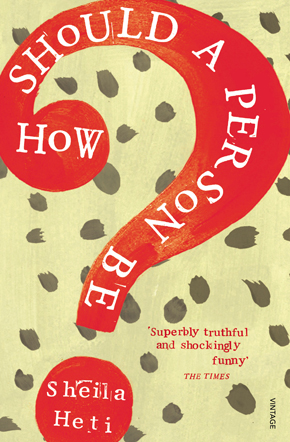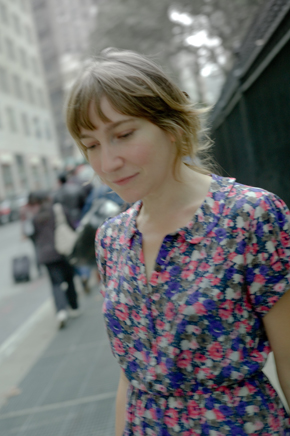Sheila Heti talks unpretty
by Alex Peake-TomkinsonSheila Heti’s most recent novel How Should a Person Be? is a book that’s not afraid of appearing ugly, either aesthetically or morally. There is even a chapter called ‘Sheila Throws Her Shit’. Its writer, however, has a generous spirit, a sincere belief in the importance of art and that same mixture of confidence and slightly disarming girlishness that Lena Dunham displays in interviews.
I ask her about her willingness to expose her own ugliness. “That’s sort of what this whole book is about. How do I put ‘my ugliness’ into the world, not hide it from myself. How do I make a book that aesthetically doesn’t seem pretty, that aesthetically doesn’t show ‘oh I’m a great writer’? The book doesn’t have that aim… and trying not to make something pretty is not a culturally accepted thing for a woman to do: to make herself unpretty, to try to do things other than appeal.
“It’s important because you have no freedom if you don’t allow yourself to go in those directions. You have no freedom at all. For me, that’s always what I’m moving towards in my life and that’s what I want in my life as a writer and a human – ever-increasing freedom, more and more freedom because with that comes greater happiness and greater access to the truth and greater relationships and a less miserable death where you think ‘What did I waste this whole life for?!’ We both laugh fairly hysterically at this before she proceeds “Where you think, ‘What did I waste all that time for, parading around in all my illusions?’”
I wonder if the many people who have commented on her work have constricted that freedom but she says, “I always read what people write about my work. To not read your reviews or the blogs – and it’s the blogs that I think of as more of a source of real feeling – I can’t understand that. Art is a conversation for the world, why would you not listen when the world talks? If you read one thing though you are so vulnerable, if you read everything then you can see there’s a panopoly of responses.”
She goes on, “If you don’t read your responses, you don’t know what works. I don’t know how you’d know what to do next. It’s like getting dressed and not looking in the mirror. You don’t know what the book looks like to the world, you only know what it looks like to yourself. You have to understand how people receive art and you can’t if you’re not looking at their responses.”
Partly because she’s so open to people’s responses to her work and partly because some of her books seem so open-ended, I’m interested in how she decides her projects are finished. How Should a Person Be? has been both celebrated and criticised for using real dialogue between her and her friends (not least a woman named Margaux) that she has recorded and transcribed. I wonder how she knew that she had finished it?
Whilst she thinks about this, Heti picks up my dog-eared proof copy of the book and starts flicking through it, back and forth. I start to worry about any notes I have in it but then she says, “I thought I was done about 147 times. I just always thought I was done. I always wanted to be done because it’s so gratifying to be done. And there was so many times that I’d give Margaux the manuscript and say ‘Look, I’m done!’ and she’d say ‘No, you’re not done, it could be better.’ For years, she kept saying ‘No, you’re not done.’ And that was really useful because I think you always feel like you want to be done because then you can feel you have made this great thing as opposed to feeling like, oh, I still haven’t figured out how this book should be, or still haven’t solved the problems of it.
 “You know it’s done because you just start making it worse. You keep editing but you realise the editing is making it worse. It’s like when you put on clothes, or you put on make-up and you realise you don’t look like yourself anymore, you’ve got too much mascara or eyeliner… it’s just like the same thing, you know you’ve gone too far because you can see it, that you’ve taken the life out of it. At a certain point, you do start stripping the life out of it. And this book had to sound sort of rough so I couldn’t edit it the way I edited Ticknor which was supposed to be like a perfect jewel. Philosophically it had to be rough so I had to hold myself back and not try and make things sound too nice.”
“You know it’s done because you just start making it worse. You keep editing but you realise the editing is making it worse. It’s like when you put on clothes, or you put on make-up and you realise you don’t look like yourself anymore, you’ve got too much mascara or eyeliner… it’s just like the same thing, you know you’ve gone too far because you can see it, that you’ve taken the life out of it. At a certain point, you do start stripping the life out of it. And this book had to sound sort of rough so I couldn’t edit it the way I edited Ticknor which was supposed to be like a perfect jewel. Philosophically it had to be rough so I had to hold myself back and not try and make things sound too nice.”
I ask her about her next book which will be Women in Clothes: Why We Wear What We Wear, a non-fiction collaboration between her and the novelist Heidi Julavits and the illustrator and writer Leanne Shapton. They interviewed 500 women about their relationship with their clothes. It is almost finished and she tells me excitedly, “I really love the book, in my head I’m thinking of it as a gift to women. It turned out so loving, having all these voices together. For instance, you might have somebody who likes to dress really provocatively next to somebody who wears a veil, next to a Hassidic Jewish woman next to an older woman… I had a lot of love for women before the book but now I have even more. I also wasn’t someone who judged people seriously on their clothes but you have instinctive feelings like ‘I don’t like those jeans or why’s she dressed like that or she looks like a slut.’ After doing this book I don’t have any feelings like that anymore.”
I’m relieved that Heti doesn’t have feelings like that anymore because I am patently wearing the wrong thing for this interview. Thankfully, she only says “Like when I see you in this purple dress all I think is, I don’t even think about how I feel about it. All I think about is what might be your relationship to your dress, or the specialness of purple to you. Clothes now more have stories to me, rather than being things I have opinions about. And again, I was not someone who had so many opinions about it to begin with! I enjoy it more and I care less now.”
I ask her how she went about working with Shapton and Julavits on the book and she says “It was amazing how well the collaboration worked out. We had different curiosities… It was quite organic for me. There was another woman who was talking about how her breasts had grown because she stopped being a vegan – it’s all really intimate stuff. She was complaining about her bras not fitting so I said ‘Why don’t we do a bra fitting at Marks & Spencer and I’ll record it.’”
Almost every article I have read on How Should a Person Be? has mentioned its line ‘Is the blow job really the great art form of our day?’ Sat in front of her now, it feels incredibly rude to mention it.”
She continues, “Most of the time I don’t wear one. I feel more uncomfortable wearing a bra. It’s weird… you’re wearing this constructed wire thing across your chest, it’s much more comfortable without. I mean today, I’m not going to not wear a bra today because I’m wearing this skin-tight shirt but if I was home I wouldn’t, if I was going to see Margaux I might not, if I was going to dinner I might not.” I must be looking aghast because she clarifies “I’m not fifteen years old though where I want to be that sexy or something and not wear one!”
I’ve enjoyed talking to Sheila Heti about bras and art but I’m aware there’s one more thing I need to ask her. My notepad has the phrase ‘blow jobs?’ on it. The reason for this is that almost every article I have read on How Should a Person Be? has mentioned its line “Is the blow job really the great art form of our day?” I went to a reading she did last year where the first question, asked by a man, was if she gave great blow jobs. I want to ask her how she feels about this but sat in front of her now, it feels incredibly rude to mention it.
I’m so embarrassed that I can barely formulate a question but Heti simply says “I don’t really care. I feel like there’s been much less inappropriate stuff than I expected. I feel like, actually, the balance – I’ve had very little creepiness. I’ve never felt any kind of fear. I’ve never felt any aggression. I’ve felt for the most part the book has actually fallen into the hands of people who haven’t abused me in any way, on Twitter or Facebook or on the internet or in real life. There’s actually been a lot of respect for the idea that maybe an author might not want to talk with them about that. People ask questions about it in interviews and I was nervous about it. I took my email off my website when the book was being published. I thought I could receive a lot of creepy things but I really don’t feel like I have. I think people understand that it would be inappropriate for the most part. I mean I’m not Kim Kardashian.
“Her persona is very sexual and my persona isn’t. The book is very sexual but I think people see the difference between a book and a person. I think most people would feel nervous about saying something to me. I don’t mean that I think Kim Kardashian should receive all the grotesqueness she receives on the internet but I think people see the difference, that this is a novel. I don’t know what I thought was going to happen but almost nothing has creeped me out.”
Sheila Heti is the author of the story collection The Middle Stories, the novel Ticknor, an illustrated book for children called We Need a Horse, featuring art by Clare Rojas. With Misha Glouberman, she wrote The Chairs Are Where the People Go, which The New Yorker chose as one of its best books of 2011. Most recently she published How Should a Person Be? which the New York Times Book Review called “odd, original, and nearly unclassifiable” and now published by Vintage in paperback and eBook.
She is an editor at The Believer magazine, conducting many interviews with writers and artists, and has written for publications including the New York Times, the Guardian, London Review of Books, n+1, McSweeney’s, Harper’s and the Paris Review.
sheilaheti.net
Alex Peake-Tomkinson is a contributing editor at Bookanista and writes book reviews and features for the Mail on Sunday, the TLS and the Daily Telegraph.
@AlexPeakeTom


